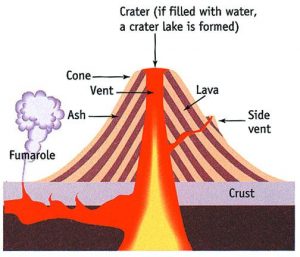Geography Notes On – Vulcanicity – For W.B.C.S. Examination.
The nature of the three main types of magma
Rhyolitic: Rhyolitic magma is viscous (‘sticky’). High viscosity is related to high silica content (65 to 75 per cent). Silica originates from the destruction and melting of plates.Continue Reading Geography Notes On – Vulcanicity – For W.B.C.S. Examination.
Rhyolitic magma traps gas and coagulates up in the vent of the volcano. Pressure builds up over time until it is suddenly released in a catastrophic eruption. Lavas have relatively low temperatures of between 650 and 900°C, flow slowly and can damage property. Large explosive eruptions can be highly dangerous.
Andesitic: Andesitic magma has intermediate viscosity, with intermediate silica content (55 to 65 per cent). Lavas have temperatures between 800 and 1000°C. Eruptions can be very destructive, especially when the volcano has been dormant and hasn’t erupted recently.
Basaltic: Basaltic magma has a low-silica content (45 to 55 per cent) and is relatively fluid because of its low viscosity (low gas content). Eruptions are effusive (non-explosive) and regular. Lavas have temperatures between 1000 and 1200°C and can flow quickly over long distances
Volcanic hazards
There are a range of volcanic hazards, which include the following:
- nuées ardentes/pyroclastic flows
- lava flows
- mudflows/lahars
- pyroclastic and ash fallout
- gases/acid rain
- tephra
The most dangerous and explosive eruptions are associated with destructive plate margins and the formation of composite volcanoes. Magma that builds these volcanoes is viscous, rich in silica with high gas content.
Large angular fragments (volcanic blocks) and aerodynamic volcanic bombs ejected during explosive eruptions are known as pyroclasts. These volcanic rocks can crush people, buildings and cars when they fall close to the volcano.
Clouds of tephra and volcanic ash ejected from the volcano can rise up and form an eruption column up to 45km into the atmosphere. It can then be transported on the wind over long distances. Tephra and ash falls will cover all surfaces including buildings, roads and farms over thousands of kilometres and cause major disruption to everyday life. The weight of ash falls can collapse buildings through roof loading; this is a fairly rare occurrence and tends to happen when over ten centimetres of ash accumulates.
If the eruption column collapses a dangerous fluid-like pyroclastic flow composed of hot rocks, ash and volcanic gases can travel down the flanks of the volcano. Pyroclastic flows are the most destructive and deadly volcanic hazards. They can move at hurricane-force speeds of up to 200 metres per second with temperatures up to 1000°C often incinerating everything in their path.
Lahars are dangerous mudflows and they represent the second greatest threat to humans after pyroclastic flows. When water from rivers, snow-capped volcanoes or crater lakes mixes with rock fragments and volcanic ash, it combines to form fast-flowing mudflows or lahars that rush down the slopes of a volcano.
Spatial distribution of volcanic hazards
The frequency of volcanic eruptions depends largely on their location.
- Composite volcanoes, located on destructive plate margins, tend to erupt infrequently due to the viscous nature of rhyolitic or andesitic magma. Plates descend deep into the mantle and melt due to the surrounding heat and friction from the subduction process. The less dense magma, rich in silica formed here, rises to the surface to create composite volcanoes with a gaseous, explosive nature. The accumulating layers of lava – ash – lava – ash … gives these volcanoes their name (‘composed’ of many layers).
- Shield volcanoes, located on constructive plate margins or hotspots, tend to erupt frequently due to the fluid nature of basaltic magma. Over a hotspot, hot and runny basaltic magma rises and breaks through at the surface. The lava travels long distances before it cools forming low, wide volcanoes (like a ‘shield’ lying on the ground).
Volcanic activity and plate margins:
• Constructive plate margins: These form chains of volcanoes that follow the line of mid-ocean ridges. Basaltic lava is produced, sometimes from fissure eruptions. Basalt has low viscosity and so plateaux of basalt can form. Volcanoes in Iceland typically start with the eruption of volcanic ash, which is then followed by basaltic lava flows. Where the eruptions are under the sea, pillow lavas form. Iceland is also well-known for having other minor forms of volcanic activity such as geysers and hot springs.
• Destructive plate margins: These tend to be more explosive because the lava has a higher silica and water content (andesite lava) than constructive margins. This forms chains of composite volcanoes made of alternating layers of ash deposits and lava. Eruptions can be very explosive (e.g. Mt St Helens 1980), blowing large volumes of rock in the atmosphere, leaving behind a huge crater or caldera e.g. that left behind after the Krakatoa eruption in 1883. Some eruptions are in the form of pyroclastic flows. These are fast-moving currents of extremely hot (1000⁰C+) gas and rock which travel away downhill from a volcano at speeds generally as great as 700 km/hour.
• Kilauea is one of the most active volcanoes on the planet and has been continuously erupting since 1983, making it the longest eruption of the last 200 years. It makes up part of the Hawaian Islands in the middle of Pacific plate. Here the eruptions tend to be relatively gentle because the basalt lava is not very viscous. Low angled shield volcanoes are formed.
Please subscribe here to get all future updates on this post/page/category/website


 Toll Free 1800 572 9282
Toll Free 1800 572 9282  mailus@wbcsmadeeasy.in
mailus@wbcsmadeeasy.in



















































































































